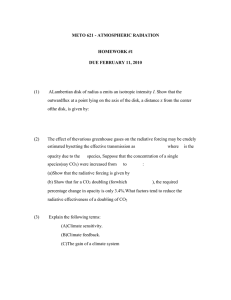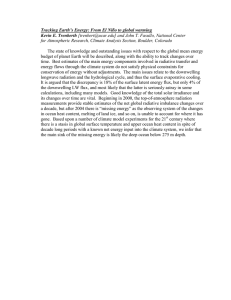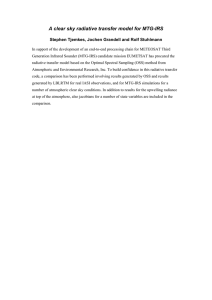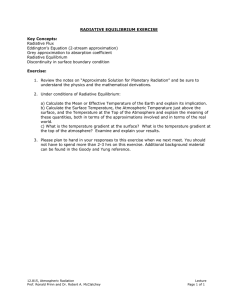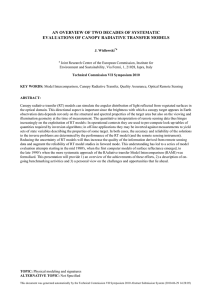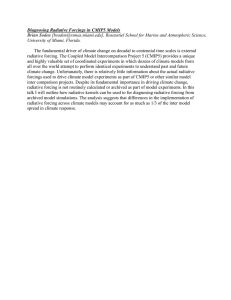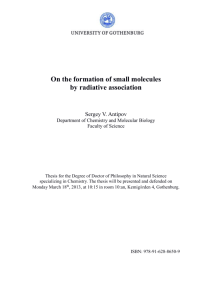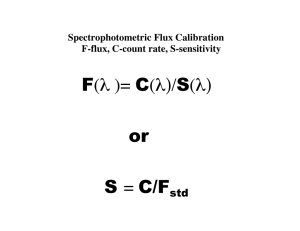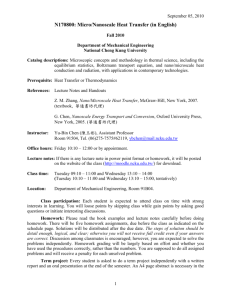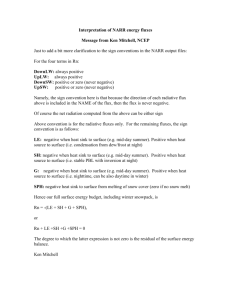Radiative Transfer Specific Intensity I defined such that I(r, θ)dΩ
advertisement
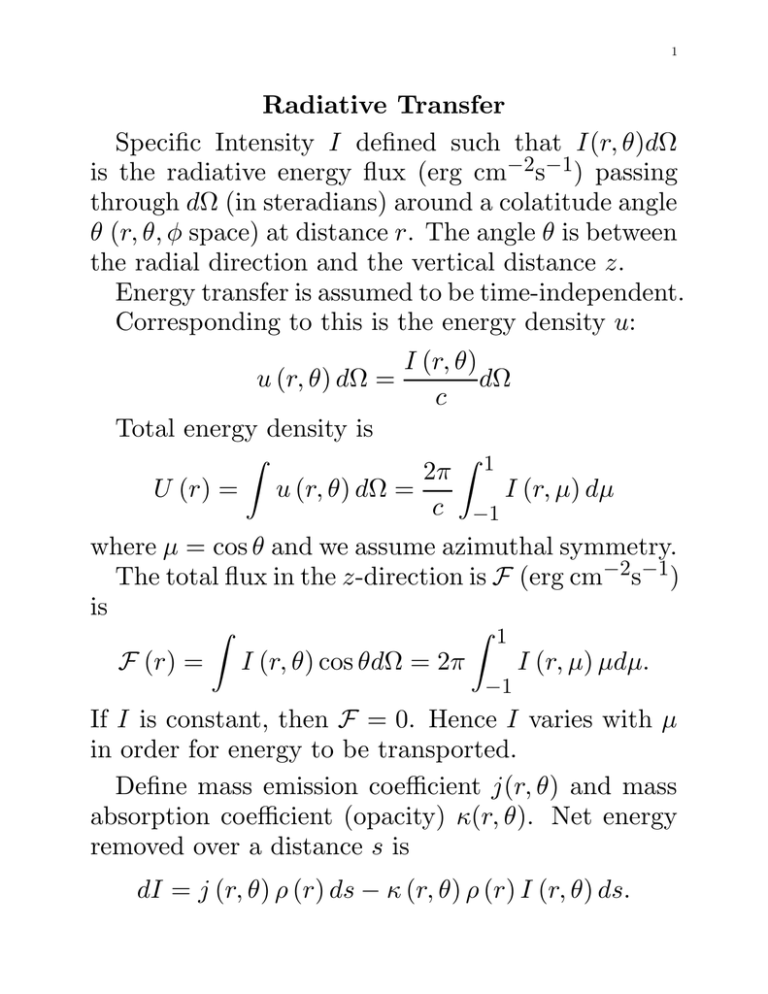
1 Radiative Transfer Specific Intensity I defined such that I(r, θ)dΩ is the radiative energy flux (erg cm−2s−1) passing through dΩ (in steradians) around a colatitude angle θ (r, θ, φ space) at distance r. The angle θ is between the radial direction and the vertical distance z. Energy transfer is assumed to be time-independent. Corresponding to this is the energy density u: I (r, θ) dΩ u (r, θ) dΩ = c Total energy density is Z Z 2π 1 I (r, µ) dµ U (r) = u (r, θ) dΩ = c −1 where µ = cos θ and we assume azimuthal symmetry. The total flux in the z-direction is F (erg cm−2s−1) is Z Z 1 F (r) = I (r, θ) cos θdΩ = 2π I (r, µ) µdµ. −1 If I is constant, then F = 0. Hence I varies with µ in order for energy to be transported. Define mass emission coefficient j(r, θ) and mass absorption coefficient (opacity) κ(r, θ). Net energy removed over a distance s is dI = j (r, θ) ρ (r) ds − κ (r, θ) ρ (r) I (r, θ) ds. 2 If j = 0 and κρ is constant, solution is I ∝ e−κρs or simple attenuation. (κρ)−1 is e-folding length for attenuation. Radiative transfer equation is 1 dI (r, θ) = j (r, θ) − κ (r, θ) I (r, θ) ρ ds which is strictly true only in planar geometry. If LTE, isotropy and spatial uniformity existed, then dI/ds = 0 and I = j/κ. Then the energy density is Z 4π 2π 1 Idµ = I = aT 4. U= c −1 c Thus −1 caT 4 2hν 3 hν/kT I= = B (T ) , Bν (T ) = 2 e −1 . 4π c Radiative transfer involves small departures from LTE. Define source function S and optical depth τ : Sν (r, θ) = jν (r, θ) /κ (r, θ) ; µ dτν = −κν ρdz dIν (µ, τν ) = Iν (µ, τν ) − Sν (µ, τν ) . dτν 3 Multiply this through by exp(−τ /µ) to find d −τ /µ e I = −e−τ /µS/µ. dτ Integrate this from τ0 to τ : Z τ0 e−(t−τ )/µ S (t) dt/µ. I (τ, µ) = e−(τ0−τ )/µ I (τ0, µ)+ τ Look first at forward-directed radiation (µ ≥ 0), choose τ0 → ∞: Z ∞ I (τ, µ ≥ 0) = e−(t−τ )/µS (t) dt/µ. τ For inward-directed radiation (µ < 0), choose τ0 = 0: Z 0 I (τ, µ < 0) = e−(t−τ )/µS (t) dt/µ. τ Note that I(0, µ < 0) = 0 if there is no incident radiation. In deep interior, reasonable to expand S S (t) = B (τ ) + (t − τ ) (∂B/∂τ )τ , where B(τ ) = B[T (τ )]. With this, the previous two expressions become I (τ, µ ≥ 0) = B (τ ) + µ (∂B/∂τ )τ , i h I (τ, µ < 0) =B (τ ) 1 − eτ /µ h i τ /µ +µ (∂B/∂τ )τ e (τ /µ − 1) + 1 . 4 But µ < 0 in the last expression, so eτ /µ → 0 for large τ , so that the first expression is then valid for all µ. Then the total flux is Z 1 F (τ ) =2π I (τ, µ) µdµ Z−1 1 4π ∂B (τ ) ∂B (τ ) =2π µdµ = . B (τ ) + µ ∂τ 3 ∂τ −1 4π 1 dT ∂Bν . 3 κν ρ dr ∂T Integrating over frequency, this is equivalent to Z ∞ 4π 1 dT ∂Bν F (r) = − dν 3 κRρ dr 0 ∂T 4ac 1 3 dT =− T . 3 κRρ dr Fν = − This equation thereby defines the Rosseland mean opacity κR, which is seen to be a suitably frequencyaveraged opacity. This equation is known as Fick’s Law of Diffusion, and is valid in regions with large optical depth. In our study of atmospheres, we must generalize this result to include small optical depth regions. Luminosity defined to be L(r) = 4πr 2F(r).
